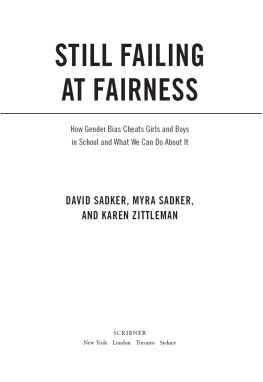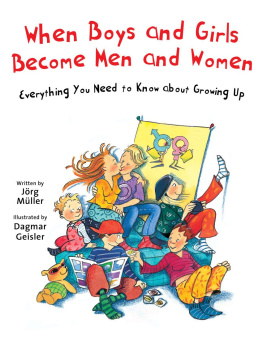Didnt we solve this sexism thing years ago?
I heard that girls are doing fine now, really better than the boys!
Its all about biology. Girls and boys brains are hardwired differently.
I read that single-sex schools are best because students focus on their work instead of each other.
Isnt there a boys crisis? Arent women the majority of college students?
A charmingly nave belief that women have achieved equality is how Newsweek columnist Anna Quindlen describes the current state of affairs. Today, men comprise over 90 percent of the top executives at Fortune 500 companiesnot exactly equity in the business world. In the military culture, female leadership is viewed as an oxymoron. Great strides in politics and journalism? Hardly. Women comprise an underwhelming 20 percent of our leading journalists. Female representation in the U.S. House of Representatives ranks a disheartening sixty-ninth in the world, behind Iraq and North Korea. Even in prestigious careers such as medicine and law, it does not take long for women to realize that their earnings lag well behind male colleagues. At big law firms, women make up less than 20 percent of the partners. Female doctors confront a gender wage gap that is actually greater than other women in the workforce.
Have you visited a Toys R Us (or any toy store) lately? They are like time machines with blue aisles for boys and pink aisles for girls, a sort of Back to the Future, 1950s style. True, a few toys target both genders, but most toys project blue and pink worlds that engulf the very young in gender-appropriate activities and futures.
College majors are not found in blue and pink aisles, but some might as well be. Forty years ago, 75 percent of students studying to be elementary teachers were female. Today, 90 percent are female. Teaching is getting pinker. Only one in five engineers is female, two-thirds of physics majors are male, and a lower percentage of females are studying computer science today than a decade ago. These are the blue majors. Even when women break free of gender stereotypes, as they have in many math and science courses, too few actually find careers in science or math.
So if females continue to be dogged by sexism, is it safe to assume that boys and men are the beneficiaries? Not at all. Gender equality is neither a competition nor is it only about females. Breaking news: boys and men have a gender. Few males even consider the heavy price they pay because of gender stereotyping. Truth is, boys are gender stereotyped earlier and more harshly than girls, and their stereotype has tighter boundaries. Careers from teaching to social work, from dance to nursing are routinely denied to countless boys. Surveys reveal that first-year college men view themselves as talented students who will earn higher grades than females, despite the fact that they read less and study less than their female peers. Why is it a revelation that they earn lower grades? Male hubris comes with a high cost.
Yet there are those who do not believe that gender bias is a problem. They believe males and females are wired differently, have different brains, and that is all part of natures plan. Across America today, hundreds of public schools have bought into this argument and created separate classrooms and different instructional strategies for males and females, setting coeducation back a century.
We have written Still Failing at Fairness to shine a light on these and other gender issues that have become so prevalent in todays schools. This new edition differs from the original in several ways:
- In many recent books on gender, the focus has been on boys in crisis. Before that, the focus was on schools cheating girls. Such approaches set the reader up for such questions as: Who is worse off, girls or boys? Are boys further behind now? Do girls no longer need to worry about gender bias? It is time we understood that gender bias and stereotypes are persistent problems for both males and females. It is not one or the other gender that is the problem; gender bias is the problem.
- The original edition of Failing at Fairness focused primarily on girls because most people assumed that girls good grades and graduation rates meant that they were doing well in school. Some still make this assumption. But the 1994 edition documented how those good grades often masked persistent problems that short-circuited girls in school. The earlier edition of Failing at Fairness also included a chapter on the male stereotype and the gender barriers boys and men confront. This time, David and Karen have worked to integrate male and female issues throughout the book.
- This new edition is also more inclusive than the first in that we have tried to integrate gender research from different racial, ethnic, and socioeconomic backgrounds. Whenever possible, we view gender through cultural and racial lenses, recognizing that each group interprets gender roles differently.
- Naturally, we have updated the research throughout the book, but readers will note that we continue to include classic studies that date from the 1980s and 1990s. It is important for the reader to understand that the federal government has been an unreliable partner in exploring and dismantling gender barriers in schools. Unsympathetic administrations have eliminated much research funding. We hope that in the years ahead, the federal government will once again become a more positive force for eliminating gender bias in schools.
- We are often asked, Is this still a problem? I heard about gender bias years ago. Isnt this old news? We respond with a question: Why wouldnt gender bias still be a problem? We are training teachers today in much the same way we did thirty years ago. While the curriculum is less gender biased than decades ago, it is still very biased. So yes, somewhere in most peoples brains there is knowledge of gender bias in schools, but without specifics and without training, we have a new generation of teachers and students who are repeating many of the gender-stereotyped lessons of those who preceded them. In this revision, we cite many sad yet current statistics that make it all too clear that gender bias is very much an issue. And the fact that some people think it is no longer a problem is reason enough to write Still Failing at Fairness.
- Each chapter now concludes with a brief section we call Succeeding at Fairness. After Failing at Fairness was originally published in 1994 a number of readers asked for practical advice, ideas, and online resources to help them create equitable home and school environments for both girls and boys. We have taken their recommendations to heart and now conclude each chapter with such suggestions.












